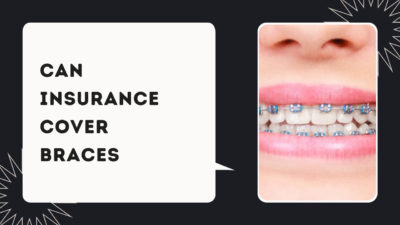Can insurance cover braces? You might be wondering. Braces are orthodontic appliances that are used to straighten your teeth or adjust your bite. Youths utilize them most frequently when their jaws are still expanding.

Nonetheless, the proportion of adults wearing braces has steadily increased over the previous two or three decades. One kind of dentist that focuses on aligning teeth and jaws is an orthodontist.
What are Braces?
Braces, often known as teeth braces, are dental devices that are used to realign teeth and treat a variety of orthodontic problems, including overcrowding, crooked teeth, and misaligned jaws.
In addition to improving the appearance of the smile, orthodontic treatment with braces lowers the risk of dental issues and makes cleaning easier. The prevalence of braces is rising in the United States.
Four million Americans wear braces or require them, and about 65% of adults do not have properly aligned front teeth. The majority of necessary treatment for braces is usually covered by dental insurance, but only for specific groups (like youngsters) or up to a predetermined percentage and limit.
Types of Insurance that Cover Braces
The types of insurance that cover braces include:
- Private Dental Insurance Plans: In return for a monthly payment, several private dental plans, provide stand-alone coverage for braces and other dental operations. You may have to pay a set copayment or coinsurance, which is a portion of your orthodontist’s fees up to an annual cap, depending on the type of plan you have.
- Group Dental Insurance Plans: Your work might provide group dental plans, which might save you money on premiums and medical expenses.
- ACA Dental Insurance: Those who purchase their health insurance through the ACA Marketplace can also get dental insurance. It might be available as a separate plan with an additional cost, as part of a package with some health insurance plans, or both, depending on your state. You have to buy it at the same time as you receive your health insurance coverage, even if it is available as an independent plan.
- Dental Savings Plans: A dental discount plan is a membership program that entitles you to savings on orthodontic and dental care services from participating dentists.
- Medicaid: States may have varying age restrictions or definitions of what is medically required, and eligibility varies by state as well. However, federal law requires states to provide dental treatment, including braces, to children participating in Medicaid or CHIP. Adult Medicaid patients can also receive dental treatment in some states, and a few states even pay for adult braces that are medically required.
- Medicare: While dental and orthodontic procedures, such as braces, are generally not covered by Original Medicare, certain Medicare Advantage plans and Medigap riders may include dental coverage; this varies by plan.
These are some types of insurance that cover it.
How Much Do Braces Cost with Dental Insurance?
If you have dental insurance, the amount you pay for braces depends on how much the plan covers. The majority of dental policies that include braces have annual and lifetime maximum benefits in addition to coinsurance levels.
Although annual and lifetime restrictions exist, several of these policies pay what appears to be a fairly generous 50% for orthodontic treatment.
Assume that the entire cost of your child’s braces is $5,000. You would owe $2,500 if your dental insurance covered only 50% of the cost.
How Much Do Braces Cost Without Dental Insurance?
The American Dental Association’s 2020 Survey of Dental Fees report states that, depending on the severity of the procedure, the average cost of braces without dental insurance ranges from $2,815 to $5,605. Adults typically pay more than teenagers, when braces are required.
Companies that Offer Insurance for Braces
Some companies that cover braces include:
- Delta Dental.
- Anthem.
- Spirit.
- Guardian.
- Ameritas.
- Cigna.
These are some insurance providers that cover it.
What are the Benefits of Braces?
The benefits include:
- Prevention of bone erosion, gum disease, and tooth decay.
- Correction of an underbite or overbite.
- It simplifies the process of brushing and flossing.
- Improvement of digestive health.
It also enhances communication and boosts confidence.
Frequently Asked Questions
Below are some frequently asked questions.
Do Insurance Policies Ever Cover Braces?
Yes, certain dental insurance policies include orthodontic treatment, which includes braces implantation, adjustments, and removal, as well as the cost of retainers and hardware, X-rays, and exams.
What Factors Affect the Cost of Braces?
The cost of braces can vary greatly depending on several factors, including your location, the length of time you will need them, the type of braces you choose, your age, the expertise of the orthodontist, how well you take care of them, how far your teeth need to be moved, etc.
Do Children’s and Adults’ Braces Get Covered by Dental Insurance?
Yes, but finding dental insurance that covers adult braces may be more challenging. Orthodontic coverage is often limited to patients under the age of 19. If you can locate insurance that covers adult braces, be sure to look for exclusions like a yearly or lifetime maximum benefit.
Conclusion
For those pursuing orthodontic treatment, dental insurance for braces can be a wise investment. The significant costs of braces and other orthodontic operations might be lessened with insurance, though coverage varies based on the particular plan.

